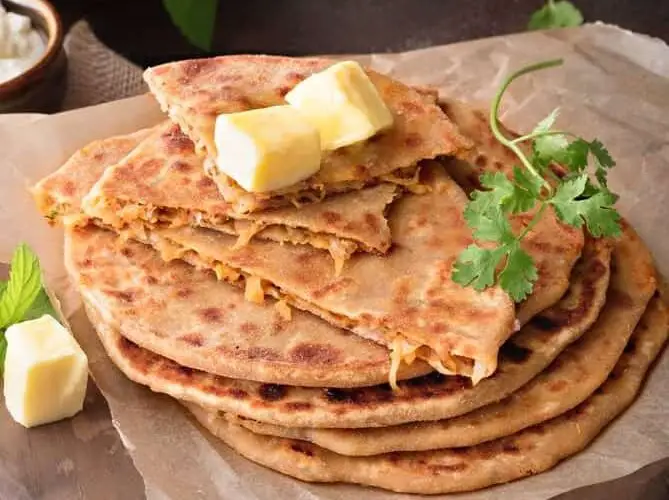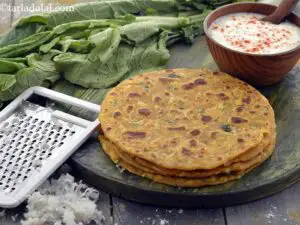The Mooli Paratha Recipe is ideal for anyone who wants to try and eat several kinds of paratha. A nice approach to include vegetables in food that children will enjoy is to make radish paratha. By combining grated radish, spices, and wheat flour when preparing conventional parathas, mooli paratha is a mild, delightful paratha. Everyone enjoys radish paratha, which is great for dinner when served with raita or pickles.
A whole wheat flatbread from Punjab called mooli paratha is packed with spicy, finely grated white radish (mooli). They go well with a side of pickle, yogurt (curd), or just a dollop of butter for breakfast, brunch, or lunch. This paratha can be made in two different ways. The stuffing is either sandwiched between two layers of dough. Alternatively, the stuffing is combined with flour and made into dough.
Ingredients for mooli paratha
for dough
- 2 cups whole wheat flour
- 2 teaspoons oil or ghee (clarified butter)
- salt add as required
- water as required
for stuffing
- 2 cups mooli (grated) white radish
- 1/2 small onion finely chopped, options
- 1/2 teaspoon dry mango powder (amchur powder)
- 1 or 2 green chilies finely chopped
- 3-4 tablespoon coriander finely chopped
- 1/4 teaspoon carom seeds ajwain
- 1/2 teaspoon red chili powder
- 1/2 teaspoon cumin seeds (jeera powder)
- 1/2 teaspoon garam masala
- oil to roast the parathas, as required (butter or ghee)
- salt add as required
Instructions for mooli paratha
for dough
- Add the wheat flour, salt, and 1 tablespoon of oil to a sizable mixing bowl or the bowl of a standing mixer. Mix it up quickly. To create a soft, smooth dough, gradually add a little water at a time and continue kneading. The final kneading should be done with the remaining 1 teaspoon of oil. Cover it and leave it to rest on the counter for 15 to 30 minutes.
for stuffing
- Using the larger (coarser) side of the grater or food processor, shred the mooli after peeling it. Give it 10 to 15 minutes to stand. You might also combine it with salt.
- When the mooli has released water after around 15 minutes, drain it. Work in batches to squeeze out extra water using a potato ricer or masher, muslin cloth, or, in my personal preference, your hands (use gloves to prevent itching) (this works the best). Put this dried, squeezed mooli in a different clean basin.
- Add the other ingredients, including the onion, green chilies, cilantro, and all the spices, including the garam masala, ajwain, red chili powder, cumin seed powder, coriander powder, and powdered dried mango. Don’t season at this time with the salt.
The stuffing for Mooli paratha is now ready.
Make Mooli Paratha
- Make five to six portions of the dough. Set a flat tawa (griddle) to medium heat and begin heating it.
- One portion of the dough should be taken, dipped in dry wheat flour, and rolled into a circle of 3 to 4 inches in diameter.
- Place 2-3 tablespoons of the filling in the center of this circle, which has been coated with ghee. Add a small amount of salt and stir it briefly.
- Bring all the ends together, squeeze, and then firmly seal.
- Remove any extra dough that remains at the peak after sealing, then use your hands to flatten the stuffed dough ball.
- Step-by-step images demonstrating how to griddle-cook the packed paratha.
Roll the stuffed, flattened dough into a circle that is 6 to 7 inches in diameter while - maintaining the direction of the linked ends. Roll out dough using wheat flour as needed. Roll while applying equal pressure for an automatic turn.
- Make sure to finish this process quickly since the longer it rests, the more the salt will cause the mooli to seep water and the dough may stick to the rolling pin, making rolling challenging.
- Place the heated tawa with the rolled paratha on it. Flip after cooking for about a minute. Apply ghee to the side that is facing up while the other side cooks.
- Once more, flip the food over and use a spatula to press the ghee-coated side until it is well-cooked and golden in color with brown spots. For the other side, repeat the procedure.
- Continue flipping and heating until both sides are evenly cooked, have brown spots, and are golden in color. Depending on how you make the parathas, some may also puff up during this process.
- Remove off tawa, stack in casserole or roti basket to keep warm until time to serve, or place on serving dish. Make the remaining parathas in a similar manner.
- Serve Mooli Paratha hot with a dollop of butter on top and a serving of pickles, green chutney, yogurt, or raita. Enjoy!!
notes
- Use white radish that is tender and soft without the leaves.
- More green chilies can be used for a hotter flavor
- Do not forget to knead the dough until it is soft and smooth.
- Ghee can be substituted with any unflavored oil for a vegan mooli paratha.
- The radish must be squeezed very firmly to thoroughly drain the water; else, the paratha may tear while rolling from the radish’s moisture. This potato ricer/masher works well at squeezing out the majority of the water, therefore I recommend using it.
- Wear gloves if you plan to squeeze the water by hand. Use gloves when handling grated mooli to prevent itching reactions in some people.
- As soon as the salt and radish are combined, you must act swiftly since the salt will cause the radish to leak forth water. I advise adding salt right before inserting the dough, at the very last minute. Alternately, use a tiny amount of filling—enough for 2–3 parathas—and season it with salt.
- To keep paratha vegan, roast it in oil. To keep paratha vegan, roast it in oil.
Nutrition
| Calories | 142kcal |
| Fat | 4g |
| Sodium |
135mg
|
| Potassium |
208mg
|
| Carbohydrates | 25g |
| Protein | 4g |
| Vitamin A |
68IU
|
| Vitamin C |
10mg
|
| Calcium | 24mg |
Also read: Fish fry recipe (step by step)
follow us on instagram, facebook and youtube


